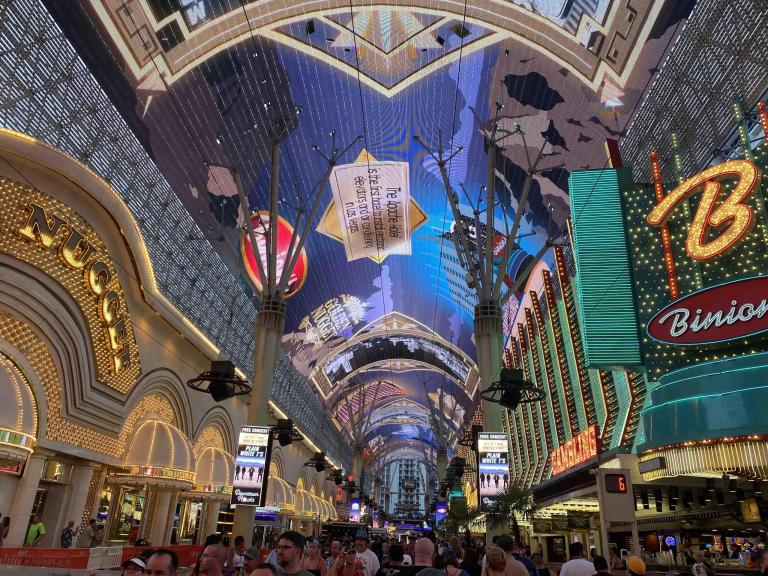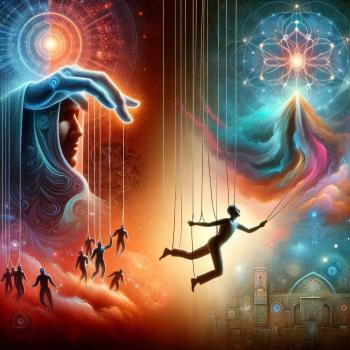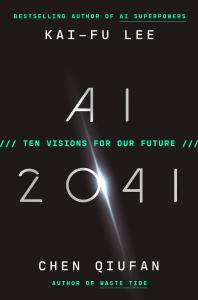In early 2020, I wrote a post titled “Fear and Loathing in the Technological City.” Those initial reflections, contrasting Jacques Ellul’s and Hunter S. Thompson’s critiques of the technological society, resulted in two conference proposals. These, along with a research trip to Los Vegas, were postponed due to COVID-19. The papers will be presented this fall, and I was able to visit Las Vegas earlier this summer.

Established in the early 20thcentury, Las Vegas is an aggressively modern city—significantly shaped by technological developments such as electricity, the machine gun, nuclear weapons, and every type of entertainment and surveillance technology. It is, as Thompson discovered, an ideal site for the exploration of technological hopes and fears.
In Fear and Loathing in Las Vegas: A Savage Journey to the Heart of the American Dream, which first appeared fifty years again in two issues of Rolling Stone, Thompson condemns the deformation of the American dream but also calls for its reformation. Thompson saw, in the growing postwar garden of “the meadows,” how human freedom and potential could be diminished in an avaricious, automated, and artificial reality. Fifty years ago, algorithms were mushrooming in the desert already. There were automatic luxury cars, hidden computers financially sorting people and optimizing operations, impersonalized services, and robot-like people serving extractive mechanisms for predictable and controllable outcomes.
With his high-tech vehicles, communication devices, pharmaceuticals, and weapons, Thompson was not interested in rejecting technology. But he did see how a technological society can suppress freedom and possibility through mercenary systems, merciless laws, and restrictive state and private surveillance. In Las Vegas, Thompson saw a manifestation of the technological city without a moral foundation or landscape. Hope and longing had been reduced to fear and loathing.
But every city is a multiplicity of images and realties—idealized, contested, complex, and hidden. As one Las Vegas writer pointed out earlier this year, Thompson was a “a tourist on a mission.” The resident knows “Las Vegas as two cities. One is ours and one is theirs … their idea of what the city means or represents is necessarily very different from the one those of us who live here experience.” Another Las Vegas writer noted: “The fiction is that Vegas is a shallow, hollow place and the Strip is the worst example of depravity and consumerism. In actuality, Vegas is an inspiring city … love for Las Vegas can only be conjured by the reality of the place itself.”
Like every city, Las Vegas is both an image of the city and the reality of the city. It is also, like every city, host to deformative and transformative dimensions of our technological society. In the Apocalypse of John—a text that captured the imagination of both Ellul and Thompson—every city and its citizens participate in two spiritual cities: the deformative city of Babylon and the transformative city of New Jerusalem. As Augustine observed, “One part of the earthly city has been made into an image of the Heavenly City.” In the Apocalypse, one of these cities is doomed to fall with evil technologies; the other is destined to triumph along with, it could be argued, good technologies. In the end, the Apocalypse reveals that ultimate hopes and longings are realized in and through the technological city.
But what distinguishes deformative from transformative technological creations is not always clear. Technologies are not simple, value-neutral tools. By design, from hammers to autonomous vehicles, technologies inherit agentic intentions and they afford certain uses that are not fully knowable. As the ancient story of Babel warns, there will be technological thresholds we will cross before we realize we should not have crossed them. At the Mob Museum and the National Atomic Testing Museum in Las Vegas, one can explore the loathsome legacies of two such thresholds—the machine gun and the atom bomb, largely created out of fearful motivations. As we continue to reflect on past and future crossings of technological thresholds, we may begin to understand what these transgressions reveal about thresholds we should not and can never cross.













